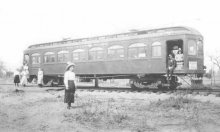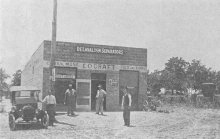Description:

Not long after statehood, the El Reno Interurban Railway Company began laying tracks west from Oklahoma City through a patch of land that once served as a timber reserve for Fort Reno. Originally exempt for settlement when the “Unassigned Lands” were opened in 1889, Council Grove, as it was then called, had been a part of the Creek Nation, and served as a gathering place for many Plains Indians attracted by the large grove of cottonwood, elm and oak trees, and good supply of spring water. Jesse Chisholm, in 1858, had even opened a trading post there.
The coming of the Rock Island Railroad relieved the government’s need for timber, and the reserve was opened for settlement in 1896. But few homesteaders ventured into the area until the prospects of an interurban line extending from Oklahoma City westward to El Reno attracted three different institutions: a Bible school, an orphanage, and a rescue home for “unfortunate girls”. To encourage other businesses and settlers, and with the hopes of selling land next to the tracks, the interurban company offered to donate 10 acres to the Church of the Nazarene, which was looking to build a school of their own.

When district superintendent of the church, C.B. Jernigan, accepted the offer, the city of Bethany was born and platted in 1909. Named after the biblical place where Lazarus was raised from the dead, Jernigan incorporated the holiness tradition of his denomination into the city charter, restricting the sale of liquor and tobacco, the establishment of theaters, dance halls and pool rooms. Church leaders intended that the little town of Bethany would reflect the religious training taught in their school, then called the Oklahoma Holiness College (now Southern Nazarene University).
Due to the fact that the railway had not yet been completed, obtaining building materials proved to be a slow and difficult process. Horse-drawn wagons were used to haul items over 10 miles of dirt roads from Oklahoma City, often an all-day process. Eventually, tents gave way to homes and businesses built of wood, concrete and brick. Incorporated by a total of 12 votes in 1910, the town grew to a population of 2,002 by 1930. It experienced rapid growth during the postwar prosperity at the end of World War II. Currently, the population stands at around 20,000.
Cutting right through the heart of the city was Route 66. In the 1950s, Route 66 became the main highway for vacationers heading west to California, and during this time, Bethany became known as the place where travelers couldn’t buy gas or cigarettes on Sundays.
Well-known residents include baseball player Allie Reynolds, who pitched for the Indians and the Yankees, and astronaut Shannon W. Lucid, for whom a Bethany Library meeting room was named and dedicated on April 3, 2004.
Resources:
- Blackburn, Bob L. Heart of the Promised Land: Oklahoma County: an Illustrated History. Woodland Hills, CA: Windsor Publications, 1982.
- Faulk, Odie B., Laura E. Faulk and Bob L. Blackburn. Oklahoma City: A Centennial Portrait. Northridge, CA: Windsor Publications, 1988.
- Gresham, Loren P. and L. Paul Gresham. From Many Came One, In Jesus’ Name: Southern Nazarene University Looks Back on a Century. Virginia Beach, VA: Donning Company Publishers, 1998.
- Jernigan, C. B. From the Prairie Schooner to a City Flat. Oklahoma City, OK: Charles Edwin Jones,1926.
- Jernigan, C. B. Pioneer Days of the Holiness Movement in the Southwest. Kansas City, MO, Pentecostal Nazarene Publishing. House, 1919.